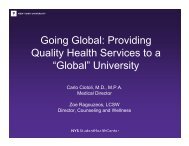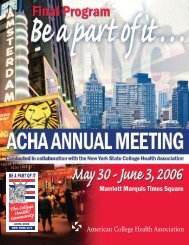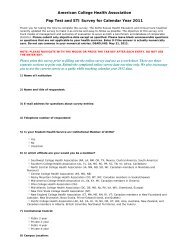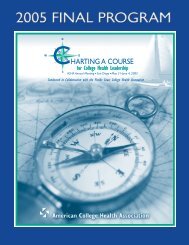KEY PARTNERSHIPS IN SEXUALVIOLENCE PREVENTIONCampus Administrators1. Create a Presidential Task Force on Campus <strong>Violence</strong>.2. Establish an institutional Position Statement on Preventing<strong>Sexual</strong> <strong>Violence</strong>.3. Acknowledge institutional commitment to reduce sexualviolence through press releases to campus community,community-at-large, alumni, and parents.4. Mandate sexual violence prevention programming for allstudents.5. Mandate the establishment <strong>of</strong> a coordinated, comprehensive,victim-centered response system for sexual violenceincidents.6. Revise Student's Code <strong>of</strong> Conduct and faculty/employeepolicies to demonstrate intolerance to sexual violence atany level.7. Maintain compliance with federal and state regulations.8. Support funding for prevention initiatives and bystanderintervention programs.9. Demonstrate mentorship to all campus constituencies foreffective collaboration.10. Participate in campus activities and programming toprevent sexual violence.Academic Affairs1. Educate students on primary prevention <strong>of</strong> all levels <strong>of</strong>sexual violence through curriculum infusion.2. Seek classroom opportunities to participate in campusprogramming and prevention activities.3. Participate in training to understand how to assist victims<strong>of</strong> sexual violence.4. Serve as mentors and role models to encourage a culture<strong>of</strong> caring.Student Affairs1. Develop programming for all campus groups such asincoming students, transfer students, internationalstudents, athletic teams, and Greek organizations.2. Serve as mentors and role models to students to encouragebehavioral change and support a culture <strong>of</strong> civilityand respect.3. Participate in training to understand how to assist victims<strong>of</strong> sexual violence.Community1. Encourage/invite community groups to participate incampus trainings to understand the culture and dynamics<strong>of</strong> campus life.2. Develop strategies for collaboration in sexual violenceprevention initiatives.3. Create partnerships for a coordinated, comprehensive,victim-centered response to sexual violence incidents.Preventing <strong>Sexual</strong> <strong>Violence</strong> Through Empowering Campus BystandersBystander interventions include a full range <strong>of</strong> optionsand levels <strong>of</strong> action, from speaking to a resident assistantabout an encounter in a residence hall to calling the police.Interventions can occur with friends, acquaintances, andstrangers, such as bartenders, designated drivers, pr<strong>of</strong>essors,hotline staff, counselors, roommates, and others. Some interventionsare best done by a group <strong>of</strong> friends and others aremore effective in private, side conversations. Staying safe isalways emphasized and balanced with keeping others safe.When people feel seriously threatened, authorities such ascampus police should be called.There are many reasons people do not intervene. Theymay not see the problem, do not know what to do, choose tomind their business, or feel out <strong>of</strong> their comfort zone. Peoplemust overcome many fears such as getting hurt, losing afriend, creating conflict, breaking a code <strong>of</strong> silence, embarrassment,or making someone angry. These obstacles to interveningshould be discussed openly and pros and cons <strong>of</strong>intervening in various situations should be flushed out by thetrainers. The moral imperative <strong>of</strong> intervening can be emphasized,as well as the benefits to the entire community. Studentscannot learn well in an atmosphere <strong>of</strong> sexual intimidation.Therefore, the entire campus community must grapple withthe questions — how can we change the campus culture thatgives rise to, promotes, creates the conditions for, condones,or ignores sexual violence on campus? How can we create aculture <strong>of</strong> caring where we do not allow humiliating, insulting,and harmful sexual attitudes and behaviors to flourish?Joetta L. Carr, PhD is a pr<strong>of</strong>essor at Western MichiganUniversity.ReferencesBanyard, V.L., Moynihan, M.M., & Plante, E.G. (2007). <strong>Sexual</strong> violence prevention through bystandereducation: An experimental evaluation. Journal <strong>of</strong> Community Psychology, 35(4), 463-481.Berkowitz, A.D. (2002). Fostering men’s responsibility for preventing sexual assault. In P.A. Schewe(Ed.), Preventing violence in relationships: Interventions across the lifespan (pp. 163-196).Washington, DC: APA.Fabiano, P.M., Perkins, H.W., Berkowitz, A.D., Linkenbach, J., & Stark, C. (2003). Engaging men associal justice allies in ending violence against women: Evidence for a social norms approach. Journal<strong>of</strong> <strong>American</strong> <strong>College</strong> <strong>Health</strong>, 5(3), 105-112.Katz, J. (n.d.). Mentors in <strong>Violence</strong> <strong>Prevention</strong> (MVP): Gender violence prevention education andtraining. Retrieved 2007 from http://www.jacksonkatz.com/mvp.html.Kilmartin, C. (2001). <strong>Sexual</strong> assault in context: Teaching college men about gender. Holmes Beach,FL: Learning Publications.Lisak, D. & Miller, P.M. (2002). Repeat rape and multiple <strong>of</strong>fending among undetected rapists.<strong>Violence</strong> and Victims. 17, 73-84.McGann, P. (2005). The effectiveness <strong>of</strong> Men <strong>of</strong> Strength Clubs. Presentation at the National <strong>Sexual</strong>Assault Conference, Pittsburg, PA. [www.mencanstoprape.org]Plante, E.G., Banyard, V.L., Moynihan, M.M., & Eckstein, R.P. (2007). Facilitator's Guide: Bringing inthe bystander. A prevention workshop for establishing a community <strong>of</strong> responsibility. [ContactVictoria Banyard (Victoria.Banyard@unh.edu) or Mary Moynihan (marym@unh.edu) for a copy <strong>of</strong>the Facilitator's Guide]Potter, S.J., Moynihan, M.M., Stapleton, J.G., & Banyard, V.L. (in press). Empowering bystanders toprevent campus violence against women: A preliminary evaluation <strong>of</strong> a poster campaign. <strong>Violence</strong>Against Women.Potter, S.J., Stapleton, J.G., & Moynihan, M.M. (in press). Designing, implementing, and evaluating amedia campaign illustrating the bystander role. Journal <strong>of</strong> <strong>Prevention</strong> and Intervention in the Community.18
Alcohol and<strong>Sexual</strong> <strong>Violence</strong>SURVEY RESULTS . . .The use <strong>of</strong> alcohol by students is the primaryreason for the majority <strong>of</strong> sexual assaults oncampus.20.2% Strongly agree48.8% Agree11.1% Unsure15.2% Disagree4.7% Strongly disagreeApproximately 50-70% <strong>of</strong> all sexual assaults involve alcohol.The relationship between alcohol and sexual violence ismultifaceted and involves different pathways. Alcohol can lowerinhibitions, impair judgment and reaction time, diminish recognition<strong>of</strong> vulnerability, reduce one’s ability to obtain or giveconsent, and decrease the capacity to resist unwanted sexualactivities (Abbey, 2002; Carr & VanDeusen, 2004). Alcoholfueledsexual aggression is anti-social behavior that harmsthousands <strong>of</strong> students each year.According to the NIAAA <strong>College</strong> Task Force Report (April2002), preconceived expectations about the effect <strong>of</strong> alcoholmay be as important as the pharmacological effect <strong>of</strong> thedrug. The influence <strong>of</strong> alcohol on behavior and judgmentmay increase misperceptions <strong>of</strong> sexual interest and lead toperpetrators ignoring refusal cues or victims disregarding riskcues. Alcohol is <strong>of</strong>ten used to blame victims, as a justificationby <strong>of</strong>fenders, and a frequent weapon in sexual violence.Thus, unwanted, pressured, and/or “regretted” sexual activitiesbecome a common occurrence among college students.A national survey indicated that approximately 44% <strong>of</strong>college students reported binge drinking (five or more drinksin a row for men and four or more in a row for women)in the last two weeks (Wechsler, et al., 2002). The Spring2007 ACHA-NCHA data showed that approximately 36%<strong>of</strong> female college students and 35% <strong>of</strong> male college studentshad an estimated Blood Alcohol Concentration (BAC) greaterthan or equal to .08 the last time they “partied” or socialized(ACHA, 2007).<strong>College</strong> drinking frequently occurs in sexually chargedsettings such as bars, nightclubs, and parties where sexual1.8% <strong>of</strong> female college students and 0.9% <strong>of</strong> male collegestudents who drank alcohol reported the consequence <strong>of</strong>having someone use force or threat <strong>of</strong> force to have sex withthem in the last school year (ACHA, 2008). The Spring 2007ACHA-NCHA also showed that 12.9% <strong>of</strong> female collegestudents and 6.2% <strong>of</strong> male college students reported someform <strong>of</strong> sexually aggressive experience within the last schoolyear. These experiences included verbal threats for sexagainst their will, sexual touching against their will, andattempted and completed sexual penetration against theirwill (ACHA unpublished data, 2008).ACHA Spring 2007 Preventing <strong>Sexual</strong> <strong>Violence</strong> Surveyactivity may be desired or expected and students may bepressured to drink. Female college students in particular are<strong>of</strong>ten targeted and incorrectly believe that they are safe amongfriends. Women are consistently rated as more culpable foracquaintance rape when they have been drinking. Humphreyand White (2000) reported that in their first year <strong>of</strong> college,31% <strong>of</strong> college women experienced some type <strong>of</strong> sexualassault and 6.4% experienced completed rape. Further,Mohler-Kuo, Dowdall, Koss, and Wechsler (2003) reportedthat 72% <strong>of</strong> female students who experienced rape were sointoxicated they were unable to consent.In order to change individual campus norms, it is necessaryto understand the context and reasons (the how, when, andwhy) that students use alcohol and the connection to sexualviolence. By obtaining data on alcohol use and sexual violenceon individual campuses and consequently identifying high-riskgroups, institutions can focus efforts to lessen high-risk alcoholuse as well as incidents <strong>of</strong> sexual violence. Campuses mightalso consider conducting focus groups <strong>of</strong> diverse studentpopulations and high-risk groups (e.g., athletes, Greeks, etc.)to determine the reasons and decisions to drink.Ultimately, collecting campus data can lead to a collaborationbetween students, faculty, staff, and administrators todevelop strategies to promote positive change appropriateto an individual campus — change that includes alcohol-freerecreation, athletic events, social activities, and campuscelebrations, as well as daily student life in residence hallsand other campus housing.The Task Force <strong>of</strong> the National Advisory Council onAlcohol Abuse and Alcoholism (April 2002) <strong>of</strong>fers a clearstructure for change around alcohol use on campuses includinga series <strong>of</strong> approximately 20 recommendations (seewww.collegedrinkingprevention.gov/StatsSummaries).<strong>Primary</strong> prevention <strong>of</strong> sexual violence holds powerfulimplications for campuses. Positive campus experiences,student safety, student retention, and student learning are highpriorities for all institutions. As campuses shift the paradigm toprimary prevention <strong>of</strong> sexual violence, the following actionsare suggested:✤Recognize that students provide the data and thesolution to changing a campus culture.19


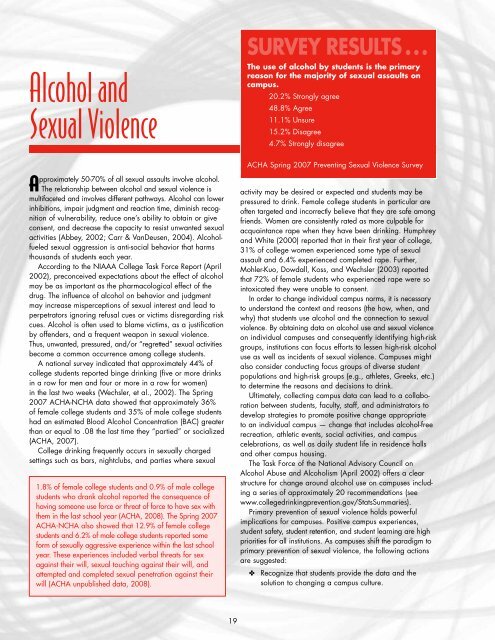
![Final Program [5.4MB pdf] - American College Health Association](https://img.yumpu.com/49022356/1/190x245/final-program-54mb-pdf-american-college-health-association.jpg?quality=85)

